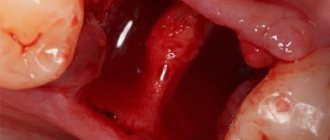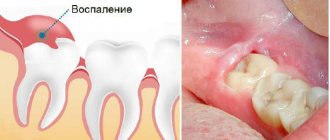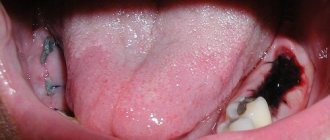What do we do when a tooth is pulled out? Even under the office, many examine the traces of the operation, fearing for its consequences. The fear intensifies after the end of the painkillers: how long should the wound hurt, and when will the bleeding stop?
Blood clot after tooth extraction
On the first day, a blood clot appears at the site of the pulled out tooth - an important condition for high-quality wound healing. In order for recovery to proceed without serious consequences, it is important to know what the wound should look like during extraction, what should and should not be done with it during the recovery period.
A few words about the procedure
Tooth extraction is a full-fledged surgical procedure. The operation consists of four stages.
- Treatment of the area around the tooth that is to be removed.
- Anesthetic injections - ampoules in carpules, where an anesthetic is combined with drugs to constrict blood vessels. Usually local anesthesia is used in the area where the nerve that innervates the problem tooth exits; if this is not enough, anesthetics are added without additional effect. When the medicine is injected into the inflamed gum with an acidic environment, part of it is inactivated, so additional anesthesia is used.
- Tooth extraction after the anesthesia has started working (the gums become numb, the blood vessels narrow). A scalpel is used to cut off the ligaments that fix the tooth. The choice of instruments and duration of the procedure depend on the condition of the tooth.
- Treatment of the oral cavity after removal: sutures (if the wound is torn or its edges are located far from each other) and a gauze swab soaked in a hemostatic agent (it must be held in the teeth for 20 minutes, since the effectiveness of the hemostatic drug increases compression of the wound). Do not rush to remove the tampon.
Gum section
Preparing for removal
Removal of a tooth
Installing a tampon
Stitching
Bleeding from the hole itself does not pose a mortal danger. In medical practice, only one case of death was recorded when blood from a wound entered the respiratory tract because the patient was intoxicated. The bleeding was complicated by cirrhosis of the liver, which interferes with clotting, and the woman had three teeth removed at once.
Professional assistance at the Berezka clinic
A dentist in a clinical setting stops bleeding in several ways, depending on the severity of the condition and the individual characteristics of the patient. It should be noted that each of the methods will be effective only if you seek medical help in a timely manner.
Stitching
The damaged vessel is ligated over the hole or soft tissue is sutured. The boas of the method stop bleeding with equal effectiveness.
Electrocoagulation
The manipulation is performed under local anesthesia. They resort to this procedure if several capillaries are damaged. The tissues are dissected using a special tool, after which they are soldered, facilitating rapid healing of the wound.
Application of fibrin film
A fibrin film is applied to the place where the tooth was removed. In addition to the hemostatic effect, the film also has an anti-inflammatory, disinfecting and healing effect.
Tamponation
In this case, the dentist uses iodoform turunda. It is inserted into the hole in the same way as a gauze swab, but to a greater depth.
Hemostatic tube
The method is relevant for patients suffering from high blood pressure. The tube is carefully inserted into the hole and held until the AT is brought back to normal.
You can also use gelatin and collagen sponges to stop bleeding.
The dentist makes a decision on the need for additional treatment procedures based on the results of examining the condition of the wound after extraction.
After operation
After three hours, the painkillers are still strong, so patients do not feel pain or it is mild. All this time, pure blood or ichor may be released from the hole. If a figure eight was removed, this can last all day, since the surgical area of the wisdom tooth is larger than that of other teeth.
Bleeding from the socket
On the second day, the hole has an unattractive appearance: a blood clot with a grayish coating. It looks like pus, but you shouldn’t be afraid of it: it’s fibrin, a substance that facilitates wound restoration. If everything goes well, the pain will be aching and will subside by the end of the day. If the nature of the pain is different - sharp, pulsating, and there is scarlet blood from the wound, you should urgently see a dentist.
At first, the hole may smell foul. There is no need to be afraid of this: blood accumulates there, and since it cannot be rinsed out, bacteria settle in the wound. If you feel normal, there is no fever, there is no reason to worry.
The rehabilitation process is normal if:
- What medicine is put into the hole after tooth extraction?
- when touching the wound, the ichor does not appear;
- the aching pain gradually disappears;
- feeling normal (temperature up to 38° is possible only in the first two hours);
- swelling on the cheek decreases (if it was not there before extraction, it should not appear at all);
- after 3 days the wound no longer bleeds.
2 weeks after removal
To reduce bleeding, you can make a tampon yourself. Positioning it so that the edges do not injure the blood clot, hold the napkin for half an hour. In the pharmacy chain you can buy a hemostatic sponge, which can be used in cases of heavy bleeding, for example, in liver failure.
Hemostatic sponge
The hole is closed with a hemostatic sponge.
You can take one or two tablets of Dicinone or Etamzilate (no more than 8 pieces per day).
Dicynone tablets
You cannot experiment with hydrogen peroxide: it reacts with blood components, destroying the blood clot and increasing blood flow.
In what cases should you seek medical help?
You should seek dental help after removing a figure eight in the following cases:
- with constant bleeding, the abundance of which does not decrease;
- with dizziness, severe headache and weakness;
- with sharp and severe pain in the gum area;
- with bloody discharge mixed with pus;
- when the elevated temperature persists for several days.
Swelling and swelling after the procedure are not a cause for concern. But when such swelling does not go away, then for your own safety it is better to visit the clinic as soon as possible.
How does the healing process work?
Even if there are no complications, the wound heals completely within four to six months.
- On the 2nd day, a blood clot appears in the socket - a protective gate against mechanical damage and infections.
- If healing proceeds normally, on the third day you can already see granulation tissue at the operation site.
- In the second week, the epithelium actively grows, and granulation tissue appears instead of a clot. Primary restoration of bone structures occurs.
- In 2-3 weeks, it displaces the blood clot and bone tissue is visible around the perimeter.
- Recreation of new tissues takes 30-45 days.
- In about 60 days, the hole is closed by osteoid tissue impregnated with calcium.
- After 4 months, the bone becomes an “adult”, with a porous structure.
- When the bone is fully formed, the wound should resolve to a third of the length of the root.
- After extraction, the gums atrophy and the process of subsidence continues for 6-12 months.
Stages of tissue healing after tooth extraction
Benefits of wisdom teeth removal at Beryozka
If you need to extract a wisdom tooth in Balashikha, we invite you to carry out such a procedure at the Beryozka clinic. Advantages of our dentists' services:
- absolute painlessness and speed of manipulation are ensured by the professionalism and experience of dental surgeons;
- During surgical interventions, the clinic’s specialists use modern anesthetics;
- minimal trauma is achieved through the use of advanced technologies during operations, which prevents bleeding and promotes rapid healing of the wound surface.
Our clinic offers an objectively affordable cost for figure eight removal and each patient receives effective dental care.
What determines the rate of tissue regeneration?
The indicated time frames are indicative information, since the restoration process is influenced by many factors:
- doctor's qualifications,
- condition of the roots,
- hygiene procedures,
- gum health
If a tooth is removed during an exacerbation of the disease, healing slows down. A lacerated wound also tightens it, especially during operations on figure eights. Particular attention is paid to high-quality treatment after the procedure. If tooth fragments remain in the hole, they will interfere with the formation of a protective blood clot, and in the end everything will end in an inflammatory process, lengthening the recovery period.
Healing socket in place of a wisdom tooth
After removal, the surgeon will definitely give advice on proper care of the wound. If you ignore advice or follow it irregularly, complications are inevitable.
Since the blood clot covers the vulnerable hole, it is important not to disturb it. If you rinse immediately after visiting the dentist, you can wash it. An unprotected wound easily becomes infected.
Rinsing after tooth extraction is prohibited
If there are problems with changes in blood pressure, sometimes the wound bleeds for a long time. Once the blood pressure normalizes, bleeding usually stops.
Precautionary measures
A wisdom tooth has been removed and the wound is bleeding – what to do in such situations? Hemorrhagic syndrome can be prevented with the help of hemostatic drugs, provided there are no contraindications.
In the first days after the manipulation, you need to brush your teeth with extreme caution and do not eat hot or hard foods. You should not stick your tongue into the hole, as such actions can damage the clot.
You should also avoid physical activity, visit the sauna, and take hot baths.
Before the procedure, you need to accurately and truthfully answer all questions asked by the doctor, especially about taking anticoagulants, aspirin and the presence of pathogenic diseases. Women do not need to hide the presence of menstruation and the use of contraceptives.
If you have high blood pressure or problems with blood clotting, you must notify your dentist.
Complications during extraction
All unfavorable conditions lead to alveolitis - inflammation that develops after infection of the wound. Most often, problems begin after a blood clot falls out. Sometimes a clot does not form at all.
- Ear hurts after wisdom tooth removal
Alveolitis of the tooth socket
If you rinse your mouth, alveolitis is diagnosed after 1-3 days. The water pressure washes away the protection and inflammation is guaranteed. Its signs:
- increasing pain, gradually affecting neighboring areas;
- as inflammation spreads, general signs of intoxication intensify: fever, aching joints, loss of strength;
- swelling spreads to nearby areas;
- the mucous membrane turns red-blue due to impaired blood supply;
- bad odor from the problem area in which food debris accumulates.
All other complications also develop after the wound becomes infected. It is convenient to present their features in a table.
| Type of complication | Description |
| Dry socket | The blood clot has not formed, recovery time is delayed, and there is a risk of alveolitis. Most often it happens during active rinsing. A dry socket should be shown to the dentist. |
| Osteomyelitis | A serious consequence when alveolitis spreads to the jaw bone. Inpatient treatment is required. |
| Nerve damage | If the tooth has massive roots, there is a possibility of nerve damage. All tissues near the tooth lose sensitivity. For treatment, a vitamin complex and medications are used that accelerate the transmission of nerve impulses to muscle tissue. |
| Cyst | A serious complication requires surgical methods of elimination. |
After recovery, there is no need to delay prosthetics, since the absence of any unit of the dentition has a bad effect on the condition of the entire oral cavity.
Prosthetics
How long does it take for a dry socket to heal?
Many people are interested in the question of how long it takes for a dry socket to heal. In the absence of complications, the wound heals in 5 - 7 days, and within a month the hole is filled with epithelial tissue. If you have dry socket, the healing process may take longer than two weeks (with proper treatment, of course). As already mentioned, extensive inflammation may occur and even require surgical hospitalization of the patient: in this case, the healing of the dry socket may be very delayed.











